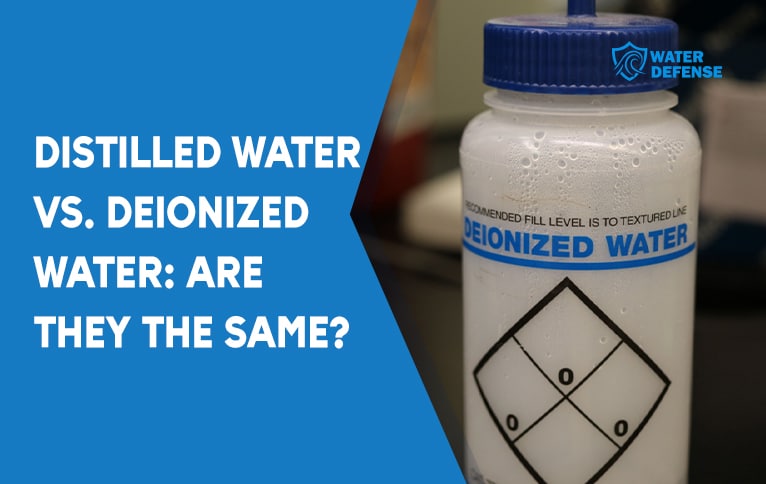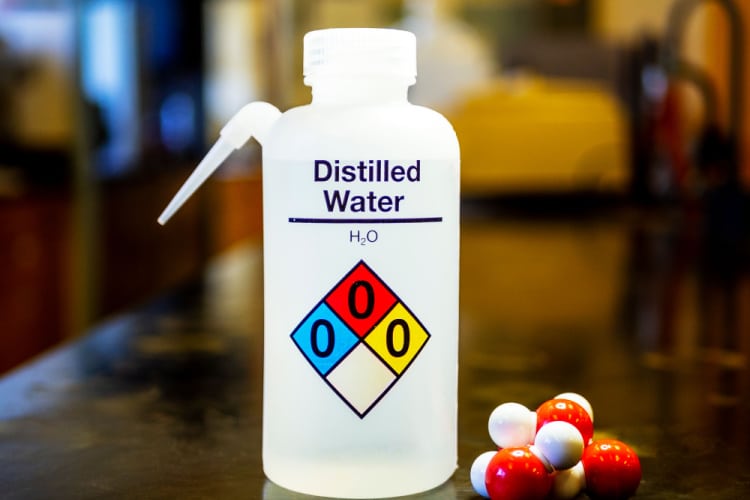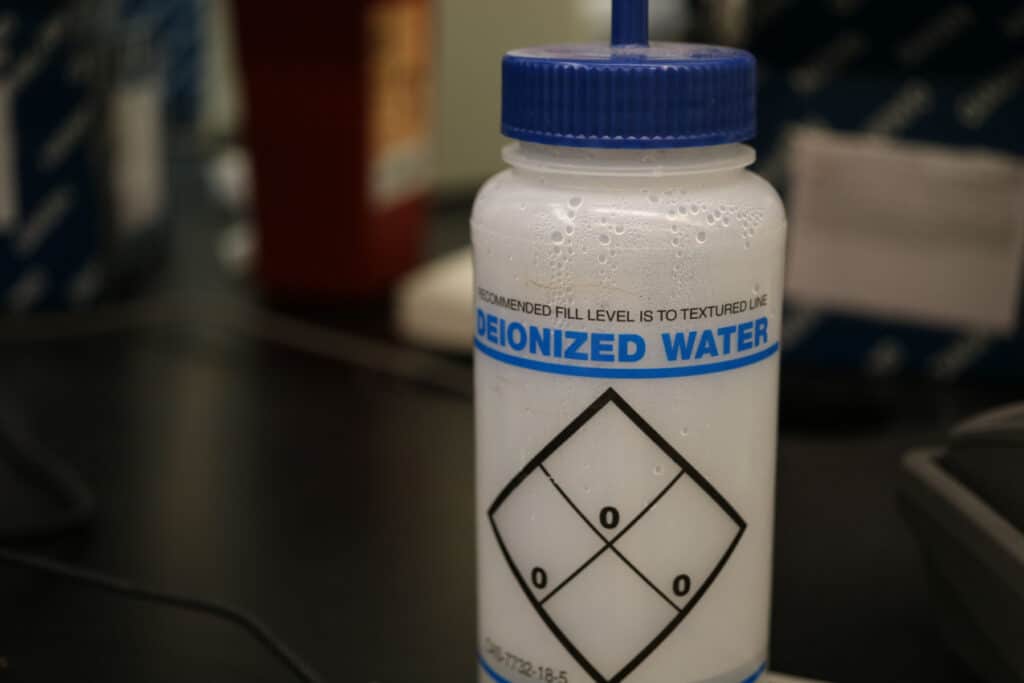The main difference between distilled and deionized water is that distilled water is contaminant-free water gotten by the distillation process, while deionized water is water that has been treated to remove the dissolved mineral salts (i.e ions). Distilled water is also the cheapest of both.
Distilled water is vaporized through exposure to heat to shed its impurities. After removing contaminants, mineral salts, and micro-organisms, the water is then cooled down to liquid state.
During its vapor state, contaminants, minerals, and pathogens can’t hold onto oxygen or hydrogen atoms. So the final product, distilled water, is completely pure water with only hydrogen and oxygen atoms.
Deionized water, on the other hand, is subjected to ion-exchange resin beds, typically one for cations (positively charged ions) and one for anions (negatively charged ions). These resin beds only remove elements with positively or negatively charged ionic structures.
Since micro-organisms, microplastics, and uncharged organic molecules don’t have any electrical charge, deionization fails to remove them. As a result, distilled water has a wider area of use (from safe drinking water to dialysis machines), while the use of deionized water is limited to industrial activities, scientific experiments, and household chores that require water with no electrical charge.

Distilled vs Deionized Water Comparison Chart
The table below shows how distilled and deionized water differs regarding their main water characteristics:
| Key water attributes | Distilled water | Deionized water |
|---|---|---|
| Collection | Water from any source (tap water, well water, spring water, surface water) can be distilled | Water from any source (tap water, well water, spring water, surface water) can be deionized |
| Treatment | Vapor distillation, condensation, and cooling down | Deionization through positively and negatively charged ion exchange resin beds |
| Targeted contaminants | All contaminants, from heavy metals and chemicals to microorganisms | Contaminants that have positively or negatively charged ionic structures |
| Mineral content | Mineral-free | Mineral-free |
| Taste | Bland | Bland |
| Areas of use | Drinking waterScientific experiments Car wash Household choresKidney dialysis machinesCPAP machinesBaby formulas and infant cereals | Scientific experimentsCar washHousehold chores |
What is Distilled Water?

The simplest definition is that distilled water is water treated through vapor distillation.
In industrial-scale vapor distillation, the untreated water is first stored inside a large tank with pipes leading to another container. A heat level of up to 212 °F is applied to this tank. As a result, the water turns into vapor and is transferred to the other container through the pipes.
When in vapor form, contaminant molecules unbind from the water molecules since the distance between atoms increases during vaporization. Then, when the vapor is condensed and cooled down during the final stage, it returns to its liquid state in a new and sterilized container, with no contaminants, minerals, or microorganisms in it. Successfully distilled water consists of only hydrogen and oxygen atoms.
Due to its pure character and the affordability of the process, distilled water has a wide area of use.
- First and foremost, distilled bottled water is a safe choice for people looking to drink contaminant-free water.
- It’s ideal for car washing and household chores such as cleaning, dishwashing, and laundry. Thanks to its mineral-free character, it doesn’t stain any household appliances or clog pipes due to mineral buildup, and it lengthens the lifespans of kitchenware and clothes.
- This makes it the perfect choice for scientific experiments and medicinal devices such as kidney dialysis and CPAP (sleep aid) machines.
- Finally, distilled water is the primary choice of parents who want to rigorously control and calculate their infant’s mineral intake. Hence, distilled water is an ideal ingredient for baby formulas and infant cereals.
Benefits & Drawbacks of Drinking Distilled Water
Just to recap, the benefits of distilled water are the following:
- It’s completely contaminant-free
- Since it has no mineral salts, it doesn’t leave any hard water stains or lead to mineral buildup
- Because it’s pure water, it’s ideal for scientific experiments and medicinal use
- Its mineral-free makeup is preferred by parents who want to keep a close eye on their baby’s nutrition
- Distillation is one of the most affordable water treatment methods
But, drinking distilled water has some disadvantages:
- Minerals such as calcium, magnesium, and potassium play essential roles in regulating our bodies. As the standard American diet is already low in these essential minerals, it’s important to digest them through water. Distilled water can’t provide that.
- Mineral salts give the water a distinct taste. Once removed, it’s inevitable that the water tastes bland, which is the case with distilled water.
What is Deionized Water?

Simply put, deionized water, or DI is water whose ions have been removed. During deionization, two different resin beds are used, one with a positive and one with a negative electrical charge.
Ions, meaning charged molecules, come in two forms: cations, which are positively charged, and anions, which are negatively charged.
Mineral salts, such as calcium and sodium, and heavy metals, such as lead and arsenic, are some of the most prominent cations. Molecular and non-atomic substances such as chloride, sulfates, and bicarbonates are anions.
To remove cations from water, you need to employ a negatively charged resin bed and to remove anions, a positively charged resin bed. These beds attract ions through their opposing electrical charges and trap them.
From time to time, deionization systems backwash themselves, flushing out the trapped ions and recharging their resin beds.
That established, deionization doesn’t remove impurities that have no electrical charge. Such contaminants include microorganisms (bacteria, viruses, microbes), microplastics, PFAS, and uncharged organic chemicals (chelating agents and many other industrial-level harsh chemicals).
So, deionized water isn’t a safe drinking water choice.
However, it has uses in other areas:
- It’s particularly useful for scientific experiments. Since it removes all the electrically charged ions from water, the water isn’t conductive anymore, which is ideal for laboratory conditions.
- It can be used in dehumidifiers. Since there are no minerals, it’ll prevent mineral buildup inside the device.
- Similar to distilled water, you can utilize deionized water for cleaning and dishwashing. Because it’s mineral-free, it won’t leave any mineral residue.
- Fish don’t like mineral-rich water. Actually, some minerals may prove toxic for them. That’s why deionized water is ideal for filling your aquarium.
On a final note, although removing cations is affordable for the most part, and traditional water softeners do it daily, we can’t say the same for the process of removing anions. Anionic exchange is expensive and has a smaller range of use, which makes deionized water more expensive than distilled water.
Benefits & Drawbacks of Drinking Deionized Water
There’s no benefit to drinking deionized water. Still, it has certain advantages in other areas (some of which we already mentioned):
- Since deionized water isn’t conductive, it’s ideal for use in labs and experiments
- Because it’s mineral-free, it won’t cause mineral buildup
- Its mineral-free character makes it ideal for cleaning chores and dishwashing
- It can be used to fill fish tanks
However, the drawbacks of deionized water may trample its benefits:
- Deionization removes all the essential minerals from water, so this type of water is not good for drinking
- It’s not entirely contaminant-free since deionization doesn’t affect uncharged substances, meaning it’s not safe for drinking
- Even if you’re sure that it’s safe to consume, deionized water tastes bland due to its mineral-free character
- Deionization is an expensive water treatment method
Conclusion: Is Distilled Water Better Than Deionized Water?
Distilled water is better than deionized water because it is safer and more affordable.
While distillation removes impurities and reduces the water to hydrogen and oxygen molecules, deionization only targets ions with a positive or negative electrical charge. Uncharged ions, microorganisms, and chemicals are all still present in deionized water, meaning distilled water is safer to drink.
In addition, distillation is a conventional water treatment method that requires some tanks, pipes, and a heat source. Deionization, however, requires two resins, one positively charged and the other negatively charged. Producing and maintaining positively charged resins is difficult and expensive, so deionization is much less used than distillation.
Additionally, neither distilled nor deionized water is the best option for drinking, since neither contains healthy minerals such as calcium, magnesium, and potassium. The healthiest water to drink is spring water.